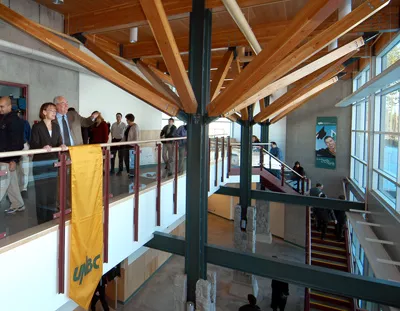GOVERNMENT FUNDS HIGH-TECH EXPANSION AT UNBC
November 22, 2004 for immediate release
The continued diversification of the northern BC economy will be onebenefit of an expansion in high-tech teaching and research that wasprofiled today at UNBC.
Advanced Education Minister Shirley Bond attended the official openingceremony for a $6.36 million expansion to the University's TeachingLaboratory, built in response to a Government of British Columbiainitiative to expand teaching and research in programs such as ComputerScience. The 23,000 square-foot addition houses computer labs,classrooms, two state-of-the-art lecture theatres, and sophisticatedcomputer labs for graphics, networking, and landscape visualization.The extension was designed by Chernoff Thompson Architects and built byWayne Watson Construction of Prince George.
Minister Bond also announced three high-tech research programs that arereceiving $1.2 million through the BC Knowledge Development Fund:
The Enhanced High Performance Computing Centre will provide the mostpowerful new computers and visualization systems in the region. Theinfrastructure will be used by several research teams to buildsimulations related to air and groundwater quality, climate and windsystems, and the effects of climate on glaciers. The equipment willalso be used to visualize information from large databases and supportapplications in interstellar chemistry, theoretical and experimentalphysics, astrophysics, computer science, and mathematics.
The Northern Soil and Groundwater Remediation Research Laboratory ledby environmental engineering professor Jianbing Li will includeadvanced remediation analytical instruments and a largethree-dimensional chamber (more than 5 cubic metres in size) withtemperature controls, providing researchers with the opportunity tosimulate environmental remediation strategies in northern soil andclimatic conditions.
New Molecular Genetics equipment will provide UNBC with uniqueopportunities for studying how genes are activated. When the humangenome was sequenced, scientists discovered that it contained only30,000 genes - less than 1% of the total human DNA. Some of the other99% is actually found in the middle of genes, and needs to be removedbefore the gene can become active. A lab at UNBC led by biochemistryprofessor Stephen Rader will use BCKDF equipment for developing newtechniques for understanding how these extraneous regions are removedfrom RNA. It's believed that errors in this natural process, known asRNA splicing, may be responsible for more than 15% of inheriteddiseases.
Each of the projects outlined above has also received funding from thefederally funded Canada Foundation for Innovation. The federal andprovincial programs have been designed to enhance the conditions forresearch and innovation at universities.
Below: UNBC President Charles Jago shows BC Advanced Education Ministerand Deputy Premier Shirley Bond the atrium of the new lab extension atUNBC.
